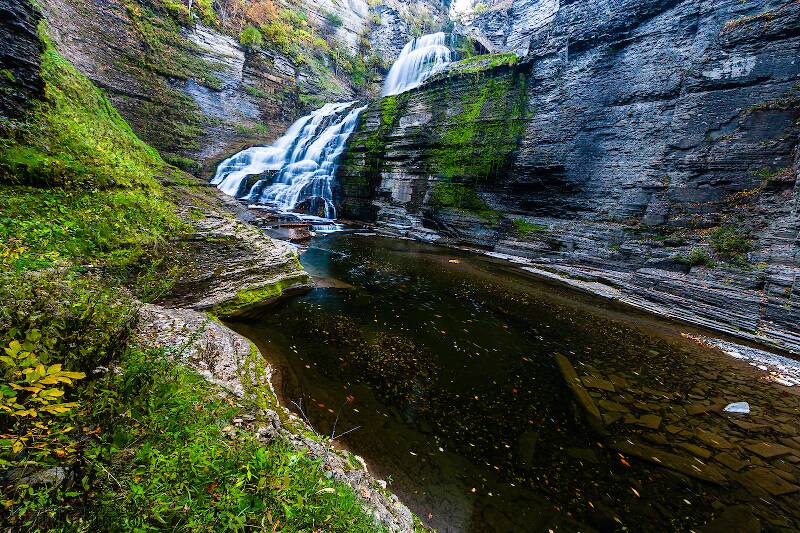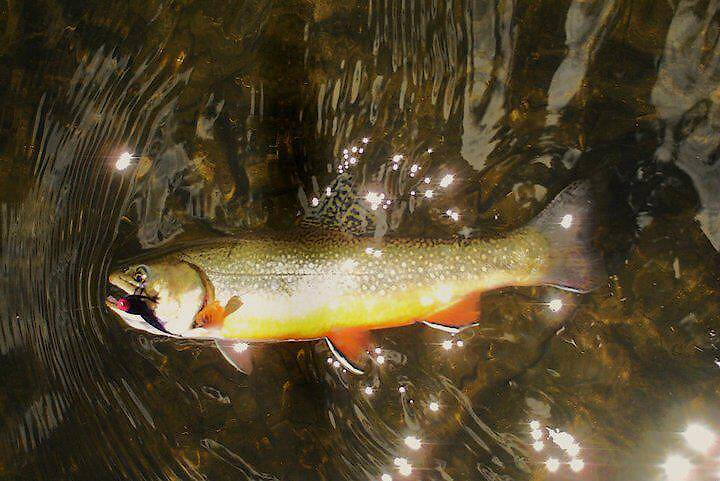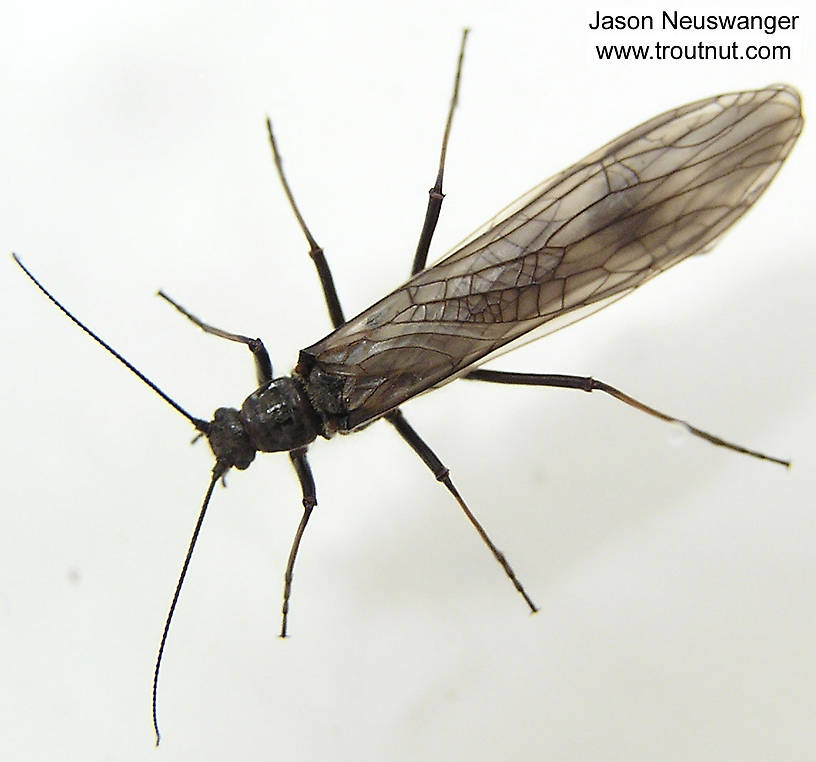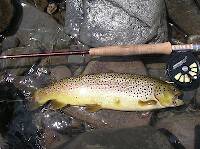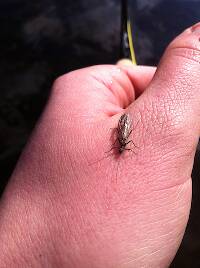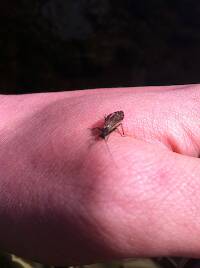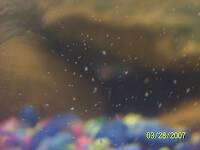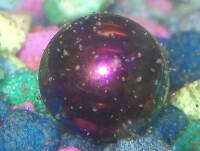
Hex Mayflies
Hexagenia limbata
The famous nocturnal Hex hatch of the Midwest (and a few other lucky locations) stirs to the surface mythically large brown trout that only touch streamers for the rest of the year.
Featured on the forum

This one seems to lead to Couplet 35 of the Key to Genera of Perlodidae Nymphs and the genus Isoperla, but I'm skeptical that's correct based on the general look. I need to get it under the microscope to review several choices in the key, and it'll probably end up a different Perlodidae.

Troutnut is a project started in 2003 by salmonid ecologist Jason "Troutnut" Neuswanger to help anglers and
fly tyers unabashedly embrace the entomological side of the sport. Learn more about Troutnut or
support the project for an enhanced experience here.
Feathers5
Posts: 287
Posts: 287
Feathers5 on Feb 21, 2012February 21st, 2012, 9:24 am EST
Are the nymphs abou a size 16 and brown in color?
Bruce
Bruce
Entoman on Feb 21, 2012February 21st, 2012, 12:35 pm EST
Hi Bruce,
The family Capniidae (Snowfly) is respsonsible for a lot of the winter stone activity and they come in both black and brown:
1. Capnia (Little Snowflies) are often black (very dark brown) and run from size 16 to size 20 or even smaller.
2. Allocapnia (Little Snowflies) are usually brown but some are black and run in the same sizes.
3. Isocapnia (Snowflies) is a larger genus that also has both Brown and Black Winter Stones and they can run from sizes 10 to 14, some a little smaller.
The family Nemouridae (Forestfly) has a few small brown Winter species that can be important as well at times. Then there's the leuctrids (Little Needleflies)... They run from size 14 to 18 and are the easiest to tell apart because they wrap their wings tightly around themselves. They also come in both colors.
Ah! I almost forgot the Early Brown and Early Black Stones of the Taeniopterygidae (Willowfly) family that can also run small, though this family is best known for its mid-sized Eastern Willowflies.
That's probably more info then you wanted, but I couldn't figure out a way to answer it any shorter. Saying either "yes" or "no" would have been misleading, and saying "perhaps" without an explanation would have been rude!:)
Regards,
Kurt
PS - Black is a relative term. In the hand they will look black, but they all have brown highlights to varying degrees when viewed under magnification.
The family Capniidae (Snowfly) is respsonsible for a lot of the winter stone activity and they come in both black and brown:
1. Capnia (Little Snowflies) are often black (very dark brown) and run from size 16 to size 20 or even smaller.
2. Allocapnia (Little Snowflies) are usually brown but some are black and run in the same sizes.
3. Isocapnia (Snowflies) is a larger genus that also has both Brown and Black Winter Stones and they can run from sizes 10 to 14, some a little smaller.
The family Nemouridae (Forestfly) has a few small brown Winter species that can be important as well at times. Then there's the leuctrids (Little Needleflies)... They run from size 14 to 18 and are the easiest to tell apart because they wrap their wings tightly around themselves. They also come in both colors.
Ah! I almost forgot the Early Brown and Early Black Stones of the Taeniopterygidae (Willowfly) family that can also run small, though this family is best known for its mid-sized Eastern Willowflies.
That's probably more info then you wanted, but I couldn't figure out a way to answer it any shorter. Saying either "yes" or "no" would have been misleading, and saying "perhaps" without an explanation would have been rude!:)
Regards,
Kurt
PS - Black is a relative term. In the hand they will look black, but they all have brown highlights to varying degrees when viewed under magnification.
"It's not that I find fishing so important, it's just that I find all other endeavors of Man equally unimportant... And not nearly as much fun!" Robert Traver, Anatomy of a Fisherman
FishThirty on Feb 22, 2012February 22nd, 2012, 4:03 am EST
Saw masses of little Stonefly all over the Lower Susquehanna last couple times out. 16-18 in size.
"What time is it? It's FISH THIRTY!"
Feathers5
Posts: 287
Posts: 287
Feathers5 on Feb 22, 2012February 22nd, 2012, 4:51 am EST
Yep, Entoman, my question needed more than a one-word answer. Sorry. I saw plenty of Black Stoneflies on Sunday during a hike that bordered a local stream. There were many stoneflies on the water and no fish rising to take them. Of course, it's a freestone stream that is stocked, has few holdovers, and gets very low in the spring and fall. Quite possibly, there may have been no fish in the section I was surveying.
Thanks,
Bruce
Thanks,
Bruce
PaulRoberts on Feb 22, 2012February 22nd, 2012, 6:35 am EST
...There were many stoneflies on the water and no fish rising to take them. ...
I've yet to have good fishing centered on the winter stones. Problem is, I think, that the early stones I've seen emerge from more turbulent water then trout are willing to hold at those times. I can catch trout all winter, but calm water is where they hold mostly. And the only place I see rising fish in winter water is to midges on those glass smooth pond-like pools, or on the big tailwaters. Mebbe I was missing something -easy to do. Outta mind, outta sight and vice versa.
You know, I've never had good fishing with the summer yellow and green stones either. They may be the most abundant streamside insect here on my mountain streams, but the numbers in trout stomachs I find don't match up. Either that bright coloration advertises toxicity, or they are just difficult for trout to catch.
Anyone else seen good little stonefly fishing, esp dry?
Entoman on Feb 22, 2012February 22nd, 2012, 7:45 am EST
Hi Bruce & Paul,
I've never had much dry fly fishing with the winter stones either, probably for the reasons you suggest, Paul. However, I usually do pretty good fishing with little PT's or a black wire Copper John trailing behind a caddis larvae.
Bruce - the odds are that the nymphs of the little guys you are seeing are a shade of brown and some can be pretty light, but the black nymphs show up better and are usually more attractive. I must admit that the tiny little black CJ's usually outfish the PT's at this time of year. I don't think the fish get that dialed into them or so selective that a dedicated imitation is all that worthwhile. I like to fish them in in the slots and runs deep in the pools, but winter fish will hold in any soft water spots, like the little inside spots at the heads of a lot of runs and along undercuts if there's not much current speed. But, there's gotta be fish! Sounds like the stream you are mentioning may not have all that many, but you might be surprised. Not seeing any rises in the middle of Winter doesn't necessarily rule out their presence. If they're there, a small little nymph drifting seductively in front of their cold noses can be hard to resist.
Little yellow stones are another matter. This is a fly worth imitating as the trout will dial in on them. There are June evenings on some rivers that they dominate the swift water runs and riffles, usually with a little caddis activity mixed in to confuse things. The nymph fished dead drift ending with a swing seems to always outfish the dries in open water. An angler seeing all kinds of fish working this fastwater as they slash away at stones will often get frustrated flogging away with the dry fly. Save the drys for fishing the seams where slow meets fast, and from the slow side. There's a lot of spots that I see in my mind's eye as I write this where some really nice fish line up along them to pick off the adults. Most guys will fish it from the fast side, with short drifts and lackluster results. Fished from the other side though, these fish often become surprisingly easy. The trick seems to be they want it floating dead drift a lot longer than is possible from the fast side.
I've never had much dry fly fishing with the winter stones either, probably for the reasons you suggest, Paul. However, I usually do pretty good fishing with little PT's or a black wire Copper John trailing behind a caddis larvae.
Bruce - the odds are that the nymphs of the little guys you are seeing are a shade of brown and some can be pretty light, but the black nymphs show up better and are usually more attractive. I must admit that the tiny little black CJ's usually outfish the PT's at this time of year. I don't think the fish get that dialed into them or so selective that a dedicated imitation is all that worthwhile. I like to fish them in in the slots and runs deep in the pools, but winter fish will hold in any soft water spots, like the little inside spots at the heads of a lot of runs and along undercuts if there's not much current speed. But, there's gotta be fish! Sounds like the stream you are mentioning may not have all that many, but you might be surprised. Not seeing any rises in the middle of Winter doesn't necessarily rule out their presence. If they're there, a small little nymph drifting seductively in front of their cold noses can be hard to resist.
Little yellow stones are another matter. This is a fly worth imitating as the trout will dial in on them. There are June evenings on some rivers that they dominate the swift water runs and riffles, usually with a little caddis activity mixed in to confuse things. The nymph fished dead drift ending with a swing seems to always outfish the dries in open water. An angler seeing all kinds of fish working this fastwater as they slash away at stones will often get frustrated flogging away with the dry fly. Save the drys for fishing the seams where slow meets fast, and from the slow side. There's a lot of spots that I see in my mind's eye as I write this where some really nice fish line up along them to pick off the adults. Most guys will fish it from the fast side, with short drifts and lackluster results. Fished from the other side though, these fish often become surprisingly easy. The trick seems to be they want it floating dead drift a lot longer than is possible from the fast side.
"It's not that I find fishing so important, it's just that I find all other endeavors of Man equally unimportant... And not nearly as much fun!" Robert Traver, Anatomy of a Fisherman
PaulRoberts on Feb 22, 2012February 22nd, 2012, 9:00 am EST
Thanks, Kurt. I'll try a nymph for the yellow stones -we sure have a lot of them.
Yeah, positioning can be everything. Can't be lazy, and sometimes one has to be downright heroic. :)
Yeah, positioning can be everything. Can't be lazy, and sometimes one has to be downright heroic. :)
Entoman on Feb 22, 2012February 22nd, 2012, 9:13 am EST
Hah! Yep... Or crazy!:)
"It's not that I find fishing so important, it's just that I find all other endeavors of Man equally unimportant... And not nearly as much fun!" Robert Traver, Anatomy of a Fisherman
Falsifly on Feb 22, 2012February 22nd, 2012, 10:01 am EST
Falsifly
When asked what I just caught that monster on I showed him. He put on his magnifiers and said, "I can't believe they can see that."
When asked what I just caught that monster on I showed him. He put on his magnifiers and said, "I can't believe they can see that."
PaulRoberts on Feb 22, 2012February 22nd, 2012, 10:02 am EST
It's not crazy when fish are involved.
Falsifly, do you have time to elaborate for us?
Falsifly, do you have time to elaborate for us?
Falsifly on Feb 22, 2012February 22nd, 2012, 10:28 am EST
Falsifly, do you have time to elaborate for us?
Is this elaborate enough?
An excerpt from one of my previous posts:
From what I can recall, it was a beautiful spring day, with small puffy-white cumulus clouds drifting mellifluously through the cerulean backdrop. The sun was set high and the scintillating water surface was smiling a radiance of welcoming heat. The breath of fresh air was gathered in gusto, as gusts of wind were interspersed upon the soothing calm. I leisurely made my way downstream, sending silky silt plumes to disperse wayward on watered wings, and stopped to cast on spots of promise from which none purposed. A small island stood amid stream blocking the view to greener pastures, as the calling to investigate beckoned for my heed. I gained vantage, from the upstream point, and peered upon the quit flow in shadow of the majestic pines set on the confining river bank. A tell-tale ring of rise gathered and spread, diminishing into oblivion, followed by another and then another. I made haste along the island’s hidden bank for the downstream point of advantage from which I planned my attack in stealth. Cautiously I regained vantage again and peered from my new position, but I was perplexed at the absence of the tell-tale sign. Nothing was all that remained, as I stood replete in the confidence that I had not compromised my presence. A gust of wind snatched my attention as I followed its progression through the swaying pine boughs, followed only moments later by the abbreviated commencement of feeding trout. It wasn’t until the second gust that the bell of reason rang itself into my empty head. It was then that a more discerning gaze caught the little stones adrift in the hidden darkness of the river bottom’s blackness and the pine’s shadowing stature. Having lost their pine footing with each wind gust of sufficient strength, they tumbled water wayward into the mouths of the patient trout. I had never before experienced the trout’s lust for the little critters, as the Wisconsin early season was in its infancy, so my fly boxes were void of the expectation. I scrambled through boxes in search of any likeness, no matter how obscure, and came up with three gifts from a friend who claimed their likeness to something I couldn’t recall. I don’t know why I felt hurried but haste was in the breeze, so I raced into action and willed the wind gusts to refrain until I was readied. Finally standing in queue I took advantage of the next approaching gust and cast beneath the wind swept boughs, aiming to intersect with an open mouth. I watched in excited anticipation as the short drift was abruptly halted, almost before its start. I spent the rest of the day preening life back into each fly, as they one by one succumbed to the viscous plucking until they were rendered useless and submitted to the bare hook bin. As the day progressed the stones were scattered far and wide upon the river stretch, and could be seen wings a buzzing as the trout lazily picked them off at every intersection of their feeding lie. Sneak up from behind, make a cast, and move on to the next fish, was the call of the day.
Falsifly
When asked what I just caught that monster on I showed him. He put on his magnifiers and said, "I can't believe they can see that."
When asked what I just caught that monster on I showed him. He put on his magnifiers and said, "I can't believe they can see that."
PaulRoberts on Feb 22, 2012February 22nd, 2012, 10:49 am EST
Could you embellish a bit more. The Tolstoy award is up for grabs.
Oldredbarn on Feb 22, 2012February 22nd, 2012, 11:32 am EST
with small puffy-white cumulus clouds drifting mellifluously through the cerulean backdrop.
Now there is some "fluffy" prose...:)
Stoneflies...Don't really know where to start, don't want to write a book here today, and can't compete with Allan's handle on the language...;)
I have fished a stretch of the so-called "Holy Water" on the mainstream of the Au Sable for decades that Rusty Gates called "Stone Fly Alley". One would be hard pressed, I think, to find many days of the year when some stone fly is not present here.
Every species has its own form of emergence, but for the most part they migrate to the edges and exit the stream before they split their wingcases open and crawl out from them as "adults". I agree with Allan's experience that he describes above and feel that except for those few that actually do emerge mid-stream, for the most part, the trout's encounters with the adult form mostly take place when they accidentily find themselves back on the water or when the females return to deposit their eggs.
For the most part they behave in a manner not all that different than their other ancient cousin the dragon-fly. P dorsata, for example, crawls out on logs, and twigs, and just about anything sticking up above the water along the edges. Their discarded "shells-of-their-former-selves" can be seen everywere and sometimes they are two and three deep. Usually only a half foot to a foot above the water.
Our Au Sable is a great deal different than the streams out west. Our bigger Browns don't usually "play" out in the open, but hide near and under structure along the edges and under cedars and tag alders hanging over the stream. There they have to see more crawling stones than we can imagine and no doubt feed on them all the time.
I do believe that the hapless do fall back in to the river as adults and the oppotunist will feed on them as they do.
I fish my dry versions tight up against these spots especially along logs and those slack areas formed along them...Imagine a bit of structure at an angle to the river...The current is pushed away to get around this point and just behind it is a quiet calmer area where struggling insects find themselves from time-to-time as they try to escape to dry land...Gulp! Too bad there mister didn't make it this time...:)
Also, up along undercut banks fish find security and bugs are trying to get a grip on some grass or whatever...Oops! Another one disappears in a nice swirl. :)
Then there are the rock-and-roll moments, like Allan's above, when they fall in to the river or when the ladies return to the river to deposit their eggs. They seem to appear from nowhere and dive bomb the stream and hit it rather hard in an attempt to shake them free...Enough of these and the larger fish just might line up. She hits the water, flies up and hits it again, and BAM! That's the end of her journey. Von Behr is smiling.
Other than these fun times, and those few species that may emerge mid-stream, the action for stones are in their "nymphal" form. Here you may find some nicer fish out in the open but deep in a run, but imitating their migration to shore isn't a bad idea either...Toss the less weighted versions near the same places I fish my dries...
Here in Michigan, from trout-chasers to steelheaders, stonefly nymphs are a must and I'd be surprised if there's a fly box here without a version or two.
Spence
"Even when my best efforts fail it's a satisfying challenge, and that, after all, is the essence of fly fishing." -Chauncy Lively
"Envy not the man who lives beside the river, but the man the river flows through." Joseph T Heywood
"Envy not the man who lives beside the river, but the man the river flows through." Joseph T Heywood
Lastchance on Feb 22, 2012February 22nd, 2012, 1:11 pm EST
Wow, Falsify. I don't know if I should puke or cry over that post. LOL!
Bruce
"Preening life back into each fly?" Oh, My
God.
Bruce
"Preening life back into each fly?" Oh, My
God.
Falsifly on Mar 1, 2012March 1st, 2012, 6:23 am EST
"Preening life back into each fly?" Oh, My
God.
Yes I can understand how “Preening life back into each fly” may have gone over some people’s head.
As we all know many flies, especially dries, exhibit the hackle and feathers of various fowl. The intent is to instill, into the imitation, a life like guise resembling that of the actual insect we are trying to mirror. After numerous casts, drifts, or a fish caught these hackles and feathers get dirty and matted which detracts from the attempt to mimic life. A bird will preen to smooth and clean its feathers not unlike the fly fisherman’s attention to renewing his fly to its intended purpose. As such I thought the term preening appropriate with respect to hackle, feather and fly.
Falsifly
When asked what I just caught that monster on I showed him. He put on his magnifiers and said, "I can't believe they can see that."
When asked what I just caught that monster on I showed him. He put on his magnifiers and said, "I can't believe they can see that."
Wiflyfisher on Mar 1, 2012March 1st, 2012, 6:30 am EST
John S.
https://WiFlyFisher.com
https://WiFlyFisher.com
Falsifly on Mar 1, 2012March 1st, 2012, 6:53 am EST
Thanks for the added perspective John. To which I might ad: Big results often come from little things.
Falsifly
When asked what I just caught that monster on I showed him. He put on his magnifiers and said, "I can't believe they can see that."
When asked what I just caught that monster on I showed him. He put on his magnifiers and said, "I can't believe they can see that."
Wiflyfisher on Mar 1, 2012March 1st, 2012, 8:23 am EST
So what is your favorite pattern for the brown stones?
John S.
https://WiFlyFisher.com
https://WiFlyFisher.com
Crepuscular on Mar 1, 2012March 1st, 2012, 9:21 am EST
Wiflyfisher you probably weren't asking me what my favorite pattern for these flies is, but I like something that I can quarter downstream in front of a target. It seems like except for in some of our low-gradient spring creeks around here in central PA, these flies seem to become very attractive to fish when they are moving across current. So any pattern that will enable you to do that is what I like, typically my early stonfly dries are stimulator-esque. With a buoyant wing of deer hair, with a palmered hackle on the abdomen. Sometimes I'll put cdc as an underwing, and then a thorax/head of dubbing with a hackle wound over it. I do not usually put the deer hair tail in the fly, not sure why I dont, just lazy I guess. In the lower gradient sterams or calmer eddies I will fish a stonefly pattern that has basically the same construction but instead of a deer hair wing I will use a tannish-grey quill wing fished dead-drift. I have had a few amazing days with this pattern on a local spring creek that wasn't supposed to have these stoneflies...I caught a three fish on Tuesday evening on these flies.
Falsifly on Mar 1, 2012March 1st, 2012, 9:22 am EST
I had never before experienced the trout’s lust for the little critters, as the Wisconsin early season was in its infancy, so my fly boxes were void of the expectation. I scrambled through boxes in search of any likeness, no matter how obscure, and came up with three gifts from a friend who claimed their likeness to something I couldn’t recall.
John, I only experienced this opportunity once, back in the infancy of the Wisconsin early season. Since, I have missed the early seasons as the westward ways have called and occupied my March and early April fishing, satiating my appetite for the beloved midge fishing. In short, I’ve yet to tie to imitate the early stones. However, the economic crunch will find me on the home waters this spring and with luck the opportunity will once again present itself. If so, I will gather my samples and try to imitate to the trout’s liking. In the book “Flies for Trout” by Dick Stewart and Farrow Allen, there is tied a likeness on page 66 by Farrow Allen himself, which I like. However, rather than the wings tied down and at rest I think the impression of wings-a-buzzing would be an improvement.
Falsifly
When asked what I just caught that monster on I showed him. He put on his magnifiers and said, "I can't believe they can see that."
When asked what I just caught that monster on I showed him. He put on his magnifiers and said, "I can't believe they can see that."
Quick Reply
Related Discussions
Topic
Replies
Last Reply

